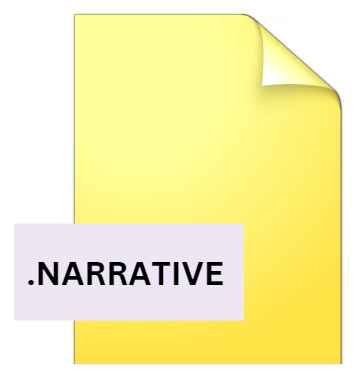.NARRATIVE File Extension

Narrator Document
| Developer | Mariner Software |
| Popularity | |
| Category | Audio Files |
| Format | .NARRATIVE |
| Cross Platform | Update Soon |
What is an NARRATIVE file?
.NARRATIVE file extension is not widely recognized as a standard file format in various software applications or operating systems.
It’s possible that the .NARRATIVE file might be a proprietary format used by a specific program or system, or it could be part of a specialized application in a niche domain such as storytelling, gaming, or interactive media.
Given the obscurity and the potential for proprietary usage, understanding the .NARRATIVE file extension requires an exploration of its conceptual origin, potential structure, and the implications of such a format in the digital realm.
More Information.
If we conceptualize the .NARRATIVE file extension as a format designed for narrative storage, its initial purpose likely revolves around the need to encapsulate complex storytelling elements in a structured, digital format.
This includes not just the narrative text, but also the interactive elements, character data, plot progression cues, and multimedia content that might be part of a digital storytelling experience.
Origin Of This File.
The .NARRATIVE file, by its naming convention, suggests a format that is potentially used for storing narratives or story-related data.
This could encompass a range of data from textual content, multimedia integration, interactive elements, and metadata about storytelling or narrative progression in digital media, games, or interactive applications.
File Structure Technical Specification.
While the specific structure of a .NARRATIVE file would depend on its originating application or system, a conceptual structure might include:
- Textual Content: The main narrative text, dialogues, descriptions, and other written content.
- Metadata: Information about the narrative, including authorship, version, narrative timeline, and character profiles.
- Interactive Elements: Data about choices, branching paths, or interactive components within the narrative.
- Multimedia Integration: References or embeds of multimedia content like images, audio, and video that are part of the storytelling experience.
- Formatting: Styling and formatting data to present the narrative in a particular aesthetic or format.
How to Convert the File?
Converting a .NARRATIVE file to a different format would typically involve using the software or platform specifically designed to handle these files. The process might include:
1. Identify the Originating Software:
- Determine which application or system the .NARRATIVE file is associated with. This could be a game engine, a digital storytelling platform, or any other specialized software.
2. Use Built-in Export Features:
- Open the .NARRATIVE file within its native application.
- Look for an ‘Export’ or ‘Save As’ feature within the application. These features are commonly found under the ‘File’ menu.
- Select the desired output format. This could be a standard format like PDF, TXT, HTML, or a format specific to another application that supports similar content.
3. Third-Party Conversion Tools (If Available):
- If the native application does not support direct conversion, or if you cannot access the native application, look for any third-party tools or services that can convert .NARRATIVE files. The availability and reliability of such tools would depend on the popularity and support of the .NARRATIVE format.
Advantages And Disadvantages.
Advantages:
- Structured Storytelling: A .NARRATIVE file could provide a structured format for complex storytelling, integrating various multimedia and interactive elements.
- Portability: If standardized, such a format could allow for the easy sharing and distribution of rich, interactive narratives across different platforms.
Disadvantages:
- Complexity: Creating and editing .NARRATIVE files might require specialized software, making them less accessible to general users.
- Compatibility: Being a non-standard format, .NARRATIVE files might face compatibility issues across different software and platforms.
How to Open NARRATIVE?
Open In Windows
1. Identify the Associated Software:
- Determine which software or application is associated with .NARRATIVE files. This information should be available from the source of the file or related documentation.
2. Install the Required Software:
- If you know the associated software, download and install it on your Windows computer. Ensure you have the latest version.
3. Open the .NARRATIVE File:
- Double-click the .NARRATIVE file, or right-click it and choose “Open” with the installed software.
- If the software doesn’t automatically recognize the file, use the software’s file browser to navigate to and open the .NARRATIVE file.
Open In Linux
1. Identify the Associated Software:
- Determine which software or application is designed to open .NARRATIVE files. Check the source of the file or related documentation.
2. Install the Required Software:
- If you know the associated software, use your package manager (e.g., APT, YUM) to install it on your Linux system.
3. Open the .NARRATIVE File:
- Launch the installed software.
- Use the software’s interface to open the .NARRATIVE file. You may need to navigate to the file location manually.
Open In MAC
1. Identify the Associated Software:
- Determine which software or application is meant to open .NARRATIVE files. This information can often be found from the source of the file or related documentation.
2. Install the Required Software:
- If you know the associated software, download and install it on your Mac. Ensure it’s compatible with your macOS version.
3. Open the .NARRATIVE File:
- Double-click the .NARRATIVE file, or right-click it and select “Open” with the installed software.
- If the software doesn’t automatically recognize the file, use the software’s file menu to navigate to and open the .NARRATIVE file.
Open In Android
1. Identify Mobile Apps (If Available):
- Search the Google Play Store for Android to see if there is a mobile app associated with the .NARRATIVE file format. It’s less common for specialized formats to have dedicated mobile apps.
2. Install the App (If Available):
- If you find a relevant app, download and install it on your Android device.
3. Transfer the .NARRATIVE File:
- If the .NARRATIVE file is on your computer, transfer it to your Android device using methods like email, cloud storage, or a USB cable.
4. Open the File within the App:
- Launch the installed app on your Android device.
- Use the app’s interface to locate and open the .NARRATIVE file.
Open In IOS
1. Identify Mobile Apps (If Available):
- Search the Apple App Store for iOS to see if there is a mobile app associated with the .NARRATIVE file format. As with Android, specialized formats may have limited mobile app support.
2. Install the App (If Available):
- If you find a relevant app, download and install it on your iOS device.
3. Transfer the .NARRATIVE File:
- If the .NARRATIVE file is on your computer, transfer it to your iOS device using methods like email, cloud storage, or file transfer apps.
4. Open the File within the App:
- Launch the installed app on your iOS device.
- Use the app’s interface to locate and open the .NARRATIVE file.













